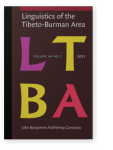Vol. 44:2 (2021) ► pp.264–296
What is a word in Brokpa?
This paper investigates the structure of phonological word and grammatical word in Brokpa, a Tibeto-Burman (Trans-Himalayan) language of Bhutan. Defining features of a phonological word include stress, tone, and segmental properties. A grammatical word is defined based on conventionalized coherence and meaning, fixed order of morphemes, and its behaviour in relation to derivational and inflectional marking. Grammatical and phonological words in Brokpa coincide in most instances. Typical mismatches include words involving non-cohering compounds and non-cohering reduplication. A formal distinction between phonological and grammatical word is the key to our understanding of the interactions between different parts of grammar in Brokpa, and help resolve potential ambiguities of the term “word” in this language.
Article outline
- 1.Introduction
- 2.Phonological word
- 2.1Stress and tone
- 2.2Phonotactic restrictions
- 2.3Diphthong position
- 2.4Other hints of phonological word boundaries
- 3.Grammatical word
- 3.1Nominal stem
- 3.2Adjectival stem
- 3.3Verbal stem
- 3.4Compounding
- 3.5Reduplication
- 3.6Non-cohering function words
- 4.Phonological word and grammatical word coincide
- 5.Phonological word and grammatical word do not coincide
- 6.Conclusion
- Acknowledgements
- Notes
- List of abbreviations
-
References
